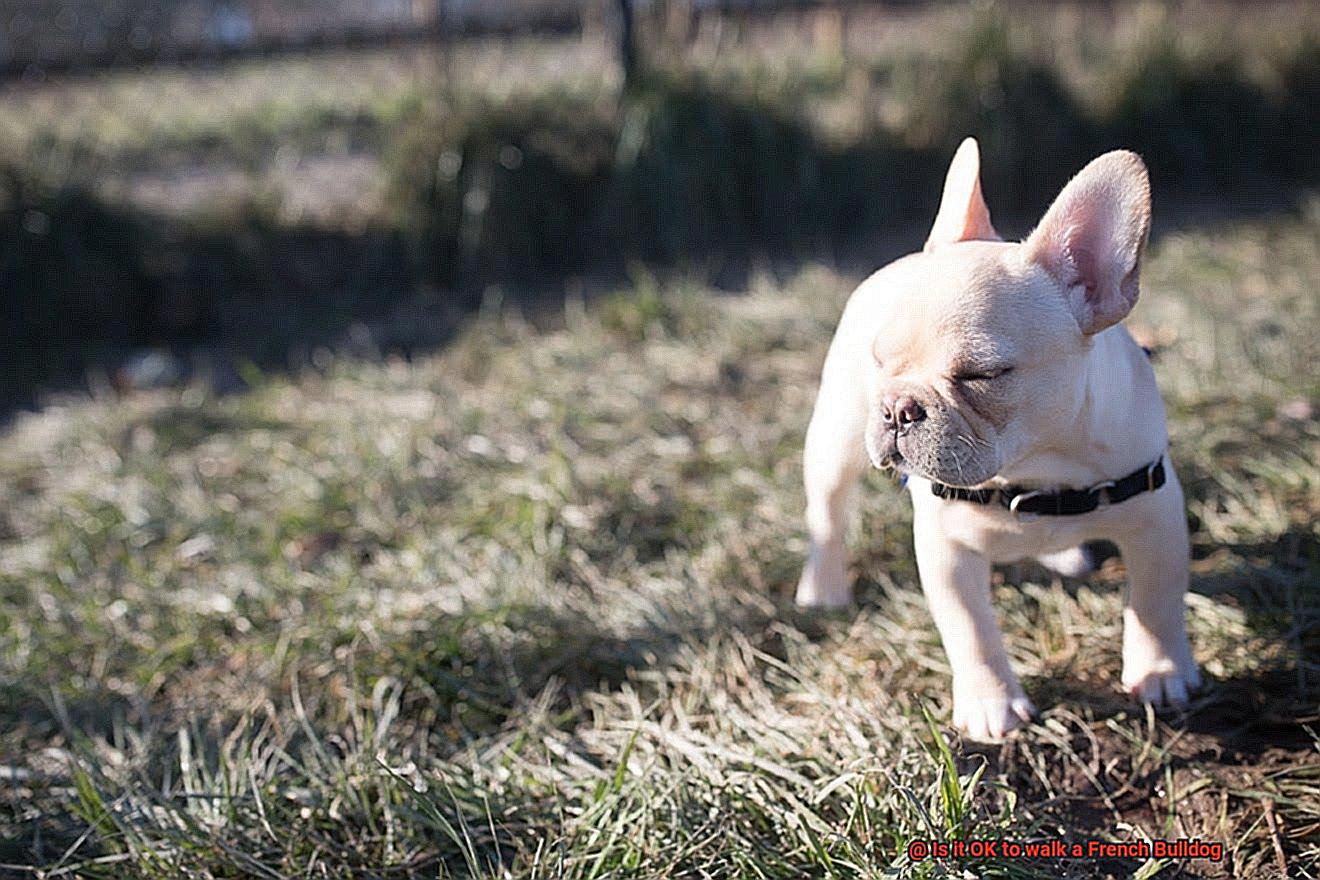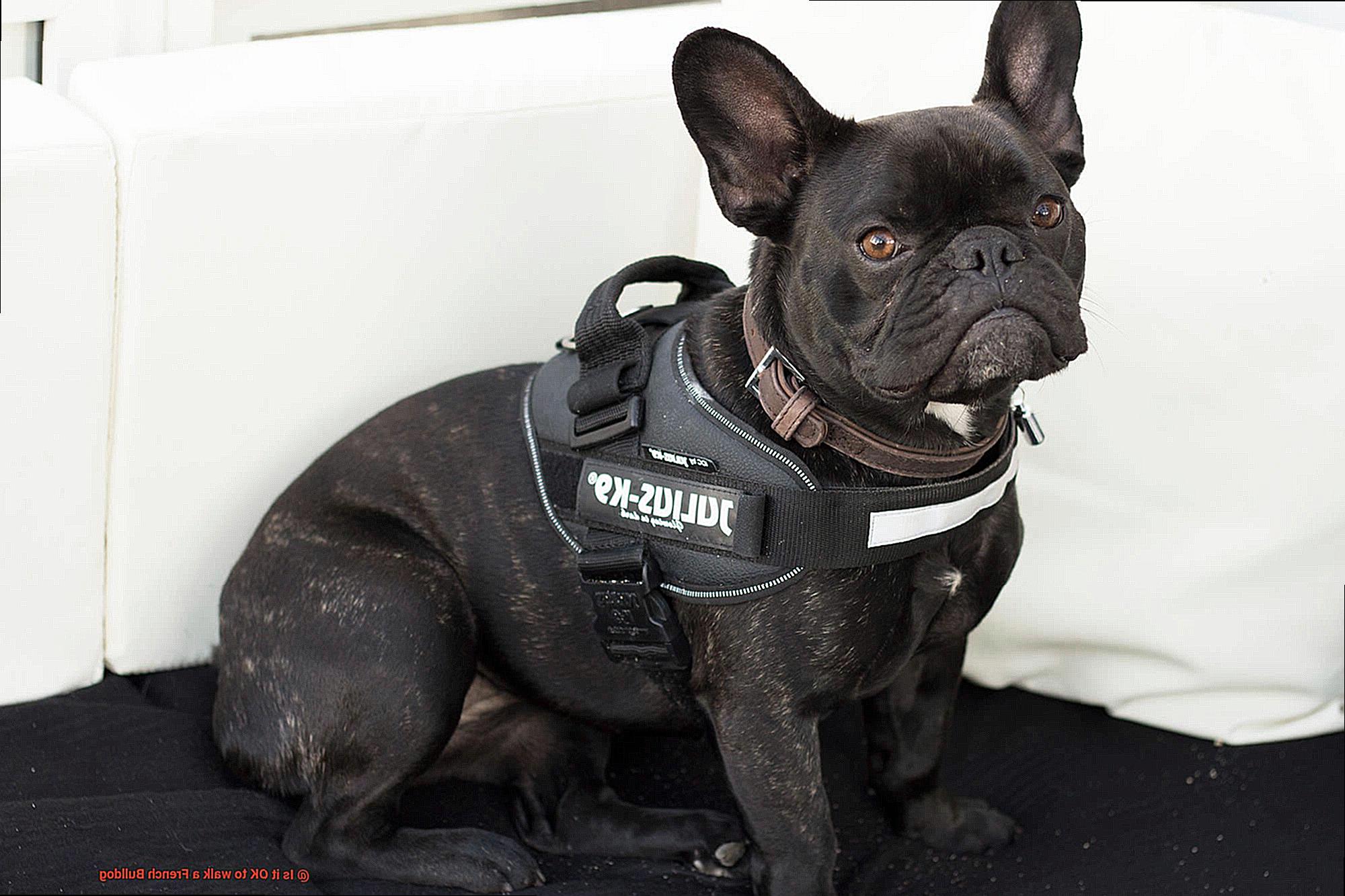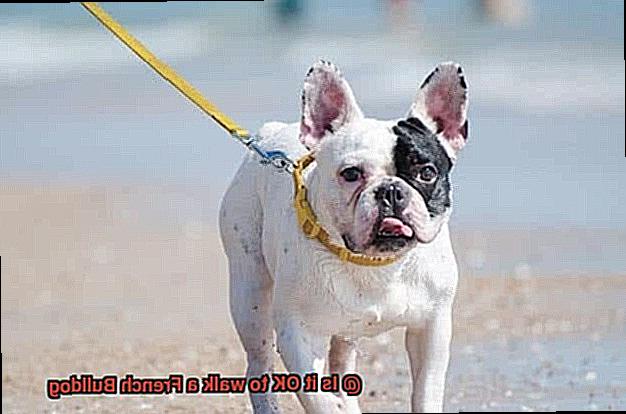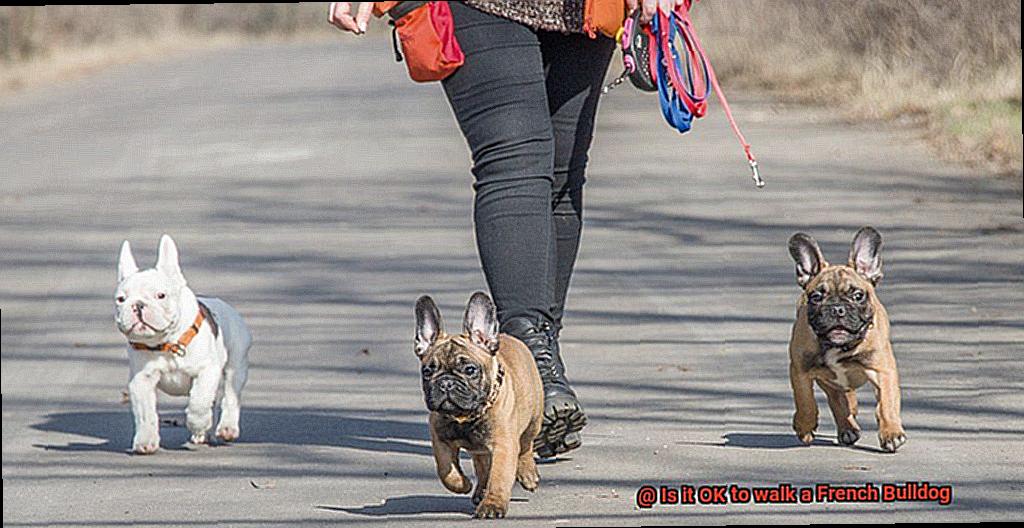Is it OK to walk a French Bulldog?
When it comes to taking them for a stroll, opinions are as diverse as their quirky personalities. Some say walking is essential for their physical and mental health, while others raise concerns about their unique vulnerabilities. In this blog post, we’re diving headfirst into the great debate on whether it’s OK to walk a French Bulldog. So grab your favorite beverage, get comfy, and let’s embark on this paw-some journey together.
Pros of Walking a French Bulldog:
- Weight Management: Just like any other doggo, French Bulldogs need regular exercise to keep those love handles in check and prevent health issues associated with obesity.
- Mental Stimulation: Taking your Frenchie for a walk opens up a world of sensory delights for them – sniffing new scents, exploring their surroundings, and engaging with the vibrant tapestry of life around them.
- Socialization Galore: Walking isn’t just good for their bodies; it’s also an opportunity for your furry friend to meet other dogs and experience different sights, sounds, and people. It’s like canine social media come to life.
Cons of Walking a French Bulldog:
- Hot Under the Collar: With their adorable squishy faces and respiratory quirks, Frenchies are prone to overheating. Walking them in scorching temperatures can put their health at serious risk.
- Breathe Easy or Not: Brachycephalic breeds like French Bulldogs have unique breathing challenges due to their short snouts. Vigorous walks or extended periods of exercise can leave them panting like they just ran a marathon.
- Handle with Care: Because of their compact size and structure, French Bulldogs are more prone to certain injuries, like joint problems and patellar luxation. Long walks or intense exercise can strain their joints and worsen these underlying conditions.
Understanding the Anatomy of a French Bulldog
Contents
- 1 Understanding the Anatomy of a French Bulldog
- 2 Avoiding Overheating During Walks
- 3 Keeping Walks Short and Leisurely
- 4 Pay Attention to the Walking Surface
- 5 Using a Harness Instead of a Collar
- 6 Carrying Water and Offering Breaks
- 7 Monitoring for Signs of Distress
- 8 Consulting with Your Veterinarian
- 9 Conclusion
French Bulldogs, with their adorable squished faces and compact bodies, are a breed that captures hearts wherever they go. But when it comes to walking these little cuties, there are a few things you need to consider. Understanding the anatomy of a French Bulldog is key to ensuring that walks are not only enjoyable but also safe for your furry friend.
Let’s start with their unique physique. French Bulldogs have a sturdy frame with a deep chest and broad shoulders, making them strong and stable. Their short and stocky legs, while cute as a button, may not be as suited for long-distance or strenuous walks compared to breeds with longer legs. So, keep those walks short and frequent to avoid placing too much strain on their little limbs.
Now, here’s where things get interesting. French Bulldogs have a respiratory system that requires special attention during physical activities. With their shortened airway and flattened face, these pups can have trouble breathing, especially in hot or humid weather. So, it’s essential to keep a close eye on their breathing during walks and make sure they don’t become overly exerted or overheated. Take breaks if needed and avoid walking during the hottest parts of the day.
Another thing to keep in mind is their tendency to gain weight easily. French Bulldogs are known for their love of food, so regular exercise is crucial for maintaining a healthy weight and overall well-being. However, just like us humans, they can experience joint issues if they’re carrying excess pounds. So, finding the right balance between exercise and portion control is key.
When it comes to choosing the right walking routes, safety is the name of the game. Avoid extreme temperatures that could be too taxing on your Frenchie’s delicate respiratory system. And watch out for surfaces that could potentially harm their paws or joints – rough terrain or long walks on hard surfaces are a no-no. Opt for more leisurely strolls on softer ground instead.
Now, let’s talk equipment. Collar or harness? While a collar may seem like the go-to choice, it can put pressure on your French Bulldog’s sensitive neck and potentially worsen any breathing difficulties. So, consider using a harness instead, which distributes the pressure more evenly and keeps your pup comfortable and safe during walks.
And last but certainly not least – hydration. Always carry water with you and offer frequent breaks for your French Bulldog to rest and hydrate. This is especially important in warmer weather when they’re more prone to overheating. A well-hydrated Frenchie is a happy Frenchie.
Avoiding Overheating During Walks
Walking your French Bulldog is a great way to keep them active and healthy, but it’s crucial to take precautions to prevent overheating. With their short noses and limited endurance, French Bulldogs are more prone to overheating than other breeds. In this guide, we’ll share seven essential tips to help you keep your furry friend cool and safe during walks.
Choose the Right Time:
Avoid walking your French Bulldog during the hottest parts of the day, such as midday. Instead, opt for early morning or late evening walks when temperatures are cooler. This will reduce the risk of overheating and ensure a more enjoyable experience for both of you.
Pace Yourself:
French Bulldogs have limited endurance and are not built for intense exercise. Keep walks shorter and take frequent breaks to allow your Frenchie to rest and cool down. Watch out for signs of fatigue, such as excessive panting or slowing down, and adjust the pace accordingly.
Watch for Signs of Overheating:
Pay close attention to your French Bulldog’s body language during walks. Look out for excessive panting, drooling, or a change in their gait. If you notice any of these signs, find a shaded area and let your Frenchie rest until they recover.
Stay Hydrated:
Always carry water with you during walks and offer it to your French Bulldog regularly. Hydration is key in preventing overheating. Consider using a portable water bottle with a built-in bowl for convenience.
Use Cooling Products:
Invest in cooling products designed specifically for dogs, such as cooling vests or bandanas. These products can help regulate your Frenchie’s body temperature and keep them cool during walks. Soak them in cold water before heading out for added effectiveness.
Mind the Walking Surface:
Avoid walking your French Bulldog on hot asphalt or concrete, as these surfaces can burn their sensitive paws. Opt for grassy areas or use protective boots to keep their paws safe and comfortable.
Consider Alternative Exercise:
On extremely hot days, when even the coolest walking conditions may be too much for your Frenchie, consider providing alternative forms of exercise. Indoor games or interactive toys can keep them mentally stimulated and physically active without the risk of overheating.
Keeping Walks Short and Leisurely
French Bulldogs are beloved for their adorable appearance and friendly nature. However, due to their unique brachycephalic anatomy, it is crucial to approach their exercise routine with care. In this blog post, we will explore why keeping walks short and leisurely is essential for the well-being of French Bulldogs. So grab a cup of coffee and let’s dive in.
Understanding Brachycephalic Anatomy:
French Bulldogs have a shortened snout and flat face, which can make breathing challenging for them, especially during physical activities. Their narrow airways restrict airflow, putting them at risk of overheating and respiratory distress.
The Importance of Short Walks:
To ensure the health and happiness of your French Bulldog, it is vital to keep their walks short. A duration of 20-30 minutes strikes a perfect balance between exercise and avoiding overexertion. Remember, quality over quantity.
Weather Considerations:
Extreme temperatures can be particularly dangerous for French Bulldogs, as they struggle to regulate their body temperature efficiently. Choose cooler times of the day, such as early mornings or late evenings, to prevent overheating. If it’s scorching outside, consider alternative forms of exercise indoors.
Pace and Intensity:
French Bulldogs are not known for their endurance or athleticism. They prefer a more leisurely pace during walks. Allow them to explore at their own speed and focus on mental stimulation through sniffing and observing their surroundings.
Monitoring Breathing:
During walks, pay close attention to your French Bulldog’s breathing. Excessive panting, wheezing, or difficulty catching their breath are red flags that they need a break. Find a shady spot, offer fresh water, and allow them time to rest before continuing.
Enjoyment for Both You and Your Frenchie:
Remember, walks should be enjoyable for both you and your French Bulldog. Embrace the opportunity to bond and create positive experiences together. Respect their limitations and don’t push them beyond what they can handle.
Pay Attention to the Walking Surface
As a proud owner of a French Bulldog, you know how important it is to take them for walks. Not only does it provide them with exercise and mental stimulation, but it also strengthens the bond between you and your furry friend.
However, when it comes to walking your French Bulldog, one crucial factor that often gets overlooked is the walking surface. Let’s dive deeper into why paying attention to the walking surface is essential for the health and well-being of your French Bulldog.
Protecting Delicate Joints
French Bulldogs have short legs and a compact body structure, making them more prone to joint problems. Walking on hard surfaces like concrete or asphalt can be harsh on their joints, leading to discomfort and potential long-term issues.
These surfaces lack cushioning and shock absorption, putting undue strain on their delicate bones and joints. To protect their joints, opt for softer surfaces such as grass, dirt trails, or rubberized paths. These surfaces provide some cushioning while they walk and reduce the risk of joint problems later in life.
Ensuring Stability and Safety
Walking on uneven surfaces can be challenging for French Bulldogs due to their short legs and body structure. They are less stable than other breeds, increasing the risk of tripping or falling. To ensure their safety during walks, choose flat and even paths. This will help prevent accidents and injuries, keeping your French Bulldog happy and healthy.
Temperature Considerations
French Bulldogs are sensitive to extreme temperatures due to their brachycephalic (flat-faced) anatomy. Walking them on hot pavement can lead to discomfort, overheating, or even burnt paws. Similarly, walking them on freezing cold surfaces can cause frostbite. It’s crucial to avoid these extremes and choose walking surfaces that are comfortable for your furry friend. If the pavement is too hot for you to comfortably place your hand on, it’s too hot for your French Bulldog’s delicate paws.
Hazard Awareness
Always keep an eye out for potential hazards on the walking surface that could harm your French Bulldog. Sharp objects, debris, or chemicals pose a threat to their well-being. Take a proactive approach and ensure a safe environment for your furry companion by promptly removing any hazards you come across during your walks.
Using a Harness Instead of a Collar
When it comes to walking your French Bulldog, using a harness instead of a collar can offer numerous advantages. Not only does a harness provide more control over your furry friend’s movements, but it also reduces strain on their neck and helps prevent potential injury. As an expert in this field, I highly recommend considering a harness for your French Bulldog’s walking needs.
- Reduced Strain on the Neck: French Bulldogs have a unique body structure with a short snout, making them more susceptible to breathing difficulties. When they pull on a collar during walks, it can put unnecessary pressure on their neck and potentially exacerbate their respiratory issues. By using a harness, you can distribute the pulling force across their chest and shoulders, reducing strain on their delicate neck area.
- Prevents Potential Injury: Collars can pose a risk of injury to your French Bulldog, especially if they have a tendency to pull or lunge during walks. A harness provides better control over their movements, preventing sudden jerks or falls that could lead to injuries like tracheal collapse or spinal damage.
- Types of Harnesses: There are different types of harnesses available, including step-in harnesses, overhead harnesses, and front-clip harnesses. Step-in and overhead harnesses are easy to put on and take off, while front-clip harnesses offer better control by redirecting your dog’s forward motion. Consider the specific needs of your French Bulldog when choosing the right type of harness.
- Escape-Proof Design: French Bulldogs are known for their mischievous nature and determination to explore their surroundings. A properly fitted harness prevents them from slipping out or escaping during walks, providing peace of mind for you as their owner.
- Proper Fit is Essential: It is crucial to ensure that the harness fits your French Bulldog properly. A poorly fitting harness can cause discomfort, chafing, or rubbing on their skin. Take accurate measurements of your dog’s chest and neck, and consult the sizing chart provided by the manufacturer to select the right size. Adjust the straps accordingly to ensure a snug yet comfortable fit.
- Transitioning from Collar to Harness: If your French Bulldog is accustomed to wearing a collar, transitioning to a harness may take some time and patience. Start by introducing the harness during short walks and gradually increase the duration as your dog becomes more comfortable. Reward positive behavior and use positive reinforcement techniques to make the transition smooth and positive.
While using a harness for walking French Bulldogs offers several advantages, it’s essential to acknowledge potential drawbacks. There is a slight risk of the dog getting tangled in the straps, so regular checks during walks are necessary.
Additionally, a harness may be less effective for leash training compared to a collar. However, considering the unique needs of French Bulldogs, the benefits of using a harness far outweigh these minor drawbacks.
Carrying Water and Offering Breaks
As a proud French Bulldog owner, you know that these adorable pups have unique needs, especially when it comes to staying hydrated and rested during walks.
In this section, we’ll explore the importance of hydration and rest for French Bulldogs, and provide practical tips to ensure their well-being while enjoying outdoor activities.
Why is hydration important for French Bulldogs?
French Bulldogs are brachycephalic dogs, which means they have a shortened muzzle and a flat face. This characteristic makes it more challenging for them to regulate their body temperature, particularly in hot weather. As a result, it’s crucial to carry water for your furry friend during walks to keep them hydrated.

Hydration is essential for all dogs, but it’s even more critical for French Bulldogs due to their respiratory issues. They often pant heavily to cool themselves down, which can lead to dehydration. To combat this, bring a portable water bottle and a collapsible bowl on walks to provide frequent water breaks for your four-legged companion.
Offering water breaks: Dos and Don’ts
When offering water breaks to your French Bulldog, find a shady spot where they can rest and cool down. It’s important to avoid letting them drink large amounts of water at once, as this can lead to gastric dilatation-volvulus (GDV), a life-threatening condition in which the stomach twists. Instead, offer small amounts of water at regular intervals to prevent overhydration.

Additionally, be mindful of the weather conditions when walking your French Bulldog. Avoid walking them during the hottest parts of the day, especially in extreme heat or high humidity. Opt for early morning or late evening walks when temperatures are cooler.
The signs of fatigue and overheating

French Bulldogs are prone to breathing difficulties and overheating due to their brachycephalic nature. It’s crucial to monitor their activity level and provide rest periods when needed.
Look out for signs of fatigue or overheating, such as excessive panting, excessive drooling, difficulty breathing, disorientation, or collapsing. If you notice any of these signs during a walk, immediately find a shaded area for your furry friend to cool down and rest.
Choosing appropriate walking surfaces
In addition to hydration and rest, it’s important to be mindful of the surface your French Bulldog is walking on. Their short legs and flat faces make them more susceptible to joint issues and injuries. Avoid walking them on rough or uneven surfaces that could cause discomfort or harm to their joints.
Monitoring for Signs of Distress
Walking your French Bulldog is a wonderful way to bond and keep them active, but it’s important to remember that these adorable pups have unique needs.
As a brachycephalic breed, French Bulldogs have a flat face and short snout, which can make it difficult for them to breathe properly, especially during physical exertion like walking. That’s why it’s crucial to monitor your furry friend for signs of distress to ensure their safety and well-being.
Why is monitoring for signs of distress important?
- Difficulty breathing: Due to their brachycephalic anatomy, French Bulldogs may experience difficulty breathing, especially in hot and humid weather conditions or when engaging in intense exercise. Excessive panting, wheezing, or gasping for air are all signs that your dog may be struggling to breathe properly and should be monitored closely.
- Heat exhaustion and heatstroke: French Bulldogs are more prone to heat exhaustion and heatstroke due to their compromised breathing ability. It’s essential to avoid walking them during the hottest parts of the day and opt for early morning or late evening walks when the temperature is cooler. Keep an eye out for excessive drooling, reluctance to continue walking, or seeking shade, as these are signs of heat-related distress.
- Hydration: French Bulldogs need regular access to water, especially during walks. Carry a water bottle and a collapsible bowl with you to offer your furry friend hydration breaks along the way. Staying hydrated is crucial for their well-being and can help prevent overheating.
- Body language: Pay close attention to your French Bulldog’s body language during walks. Signs of distress may also include reluctance to continue walking, excessive panting, or seeking shade. If you notice any of these signs, it’s best to stop the walk and allow your dog to rest.
Tips for monitoring your French Bulldog during walks:
- Choose the right time: Opt for early morning or late evening walks when the temperature is cooler. Avoid walking during the hottest parts of the day to minimize the risk of heat-related distress.
- Take frequent breaks: French Bulldogs may not have the endurance of other dog breeds due to their respiratory issues. Plan shorter walks with regular breaks to allow your dog to rest and catch their breath.
- Watch for signs of fatigue: Keep an eye out for signs of fatigue, such as lagging behind, slowing down, or excessive panting. These are indications that your dog may be tired and in need of a break.
- Consult a veterinarian: If you observe any concerning symptoms or if your French Bulldog consistently struggles with walking, it’s advisable to consult a veterinarian. They can provide further guidance on appropriate exercise levels and any potential underlying health issues.
Consulting with Your Veterinarian
Walking your French Bulldog is a great way to keep them active and healthy. However, due to their unique breed characteristics and potential health issues, it’s crucial to consult with your veterinarian before starting a walking routine. As an experienced veterinarian with a specialization in French Bulldogs, I understand the importance of seeking professional guidance. In this blog post, I will explain why consulting with your veterinarian is essential and provide helpful tips for walking your French Bulldog safely.
Brachycephalic Anatomy:
French Bulldogs have a brachycephalic (shortened muzzle) anatomy, which can lead to breathing difficulties and overheating during physical activities like walking. Consulting with your veterinarian will help you understand the potential risks associated with these conditions and how to take proper precautions.
Specific Health Conditions:
French Bulldogs are prone to certain medical conditions that can affect their ability to walk or engage in strenuous exercise. Joint problems like hip dysplasia or patellar luxation can cause pain and discomfort while walking. Your veterinarian will assess your dog’s individual needs and provide advice on managing or preventing these conditions from worsening.
Weight Management:
Obesity is a common issue among French Bulldogs due to their lower activity levels and tendency to overeat. Regular exercise, such as walking, plays a vital role in maintaining their weight and overall health. However, it’s important to consult with your veterinarian about the appropriate duration and intensity of walks based on your dog’s unique needs.
Individualized Recommendations:
Each French Bulldog is different, and what works for one may not work for another. Consulting with your veterinarian allows them to evaluate your dog’s specific needs, health conditions, and breed characteristics. They can provide personalized recommendations on the ideal exercise routine for your French Bulldog, ensuring their safety and well-being.
iMpXeyX8VT4″ >
Conclusion
In conclusion, it is absolutely acceptable to walk a French Bulldog. These adorable little creatures may have certain physical limitations due to their brachycephalic nature, but with proper care and attention, they can enjoy regular walks just like any other dog. It is important, however, to be mindful of their unique needs and take precautions to ensure their safety and well-being.
French Bulldogs are known for their compact size and muscular build, which makes them great companions for walks. Regular exercise is essential for maintaining their overall health and preventing obesity. Going on walks not only helps them burn off excess energy but also provides mental stimulation through exposure to new sights, sounds, and smells.
That being said, it is crucial to consider the weather conditions before taking your French Bulldog out for a walk. Their short snouts make them susceptible to heatstroke in hot weather, so it’s best to avoid walking during the hottest parts of the day or opt for shorter walks in shaded areas. On the flip side, extreme cold can also be challenging for them, so bundle them up appropriately if you live in a colder climate.
Additionally, it’s important to keep in mind that French Bulldogs have a tendency towards respiratory issues due to their flat faces. They may struggle with breathing during intense physical activity or in hot and humid conditions. Be attentive to signs of discomfort such as excessive panting or wheezing and adjust the intensity and duration of the walk accordingly.
To ensure a safe and enjoyable walking experience for both you and your French Bulldog, invest in a well-fitting harness rather than relying on collars that can put pressure on their delicate necks. This will help distribute weight evenly across their bodies and minimize strain on their necks and airways.
In summary, walking a French Bulldog is perfectly fine as long as you take into account their specific needs.
With proper precautions such as monitoring weather conditions, adjusting intensity levels based on their comfort, and using a harness for added safety, you can provide your furry friend with the exercise and mental stimulation they need to thrive.




